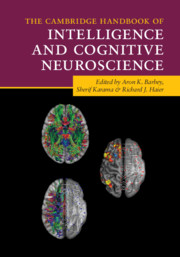Book contents
- The Cambridge Handbook of Intelligence and Cognitive Neuroscience
- Reviews
- The Cambridge Handbook of Intelligence and Cognitive Neuroscience
- Copyright page
- Dedication
- Contents
- Figures
- Tables
- Contributors
- Preface
- Part I Fundamental Issues
- 1 Defining and Measuring Intelligence
- 2 Network Neuroscience Methods for Studying Intelligence
- 3 Imaging the Intelligence of Humans
- 4 Research Consortia and Large-Scale Data Repositories for Studying Intelligence
- Part II Theories, Models, and Hypotheses
- Part III Neuroimaging Methods and Findings
- Part IV Predictive Modeling Approaches
- Part V Translating Research on the Neuroscience of Intelligence into Action
- Index
- References
1 - Defining and Measuring Intelligence
The Psychometrics and Neuroscience of g
from Part I - Fundamental Issues
Published online by Cambridge University Press: 11 June 2021
- The Cambridge Handbook of Intelligence and Cognitive Neuroscience
- Reviews
- The Cambridge Handbook of Intelligence and Cognitive Neuroscience
- Copyright page
- Dedication
- Contents
- Figures
- Tables
- Contributors
- Preface
- Part I Fundamental Issues
- 1 Defining and Measuring Intelligence
- 2 Network Neuroscience Methods for Studying Intelligence
- 3 Imaging the Intelligence of Humans
- 4 Research Consortia and Large-Scale Data Repositories for Studying Intelligence
- Part II Theories, Models, and Hypotheses
- Part III Neuroimaging Methods and Findings
- Part IV Predictive Modeling Approaches
- Part V Translating Research on the Neuroscience of Intelligence into Action
- Index
- References
Summary
The purpose of this chapter is to review key principles and findings of intelligence research, with special attention to psychometrics and neuroscience. Following Jensen (1998), the chapter focuses on intelligence defined as general intelligence (g). g represents variance common to mental tests and arises from ubiquitous positive correlations among tests (scaled so that higher scores indicate better performance). The positive correlations indicate that people who perform well on one test generally perform well on all others. The chapter reviews measures of g (e.g., IQ and reaction times), models of g (e.g., Spearman’s model and the Cattell-Horn-Carroll model), and the invariance of g across test batteries.
- Type
- Chapter
- Information
- Publisher: Cambridge University PressPrint publication year: 2021



